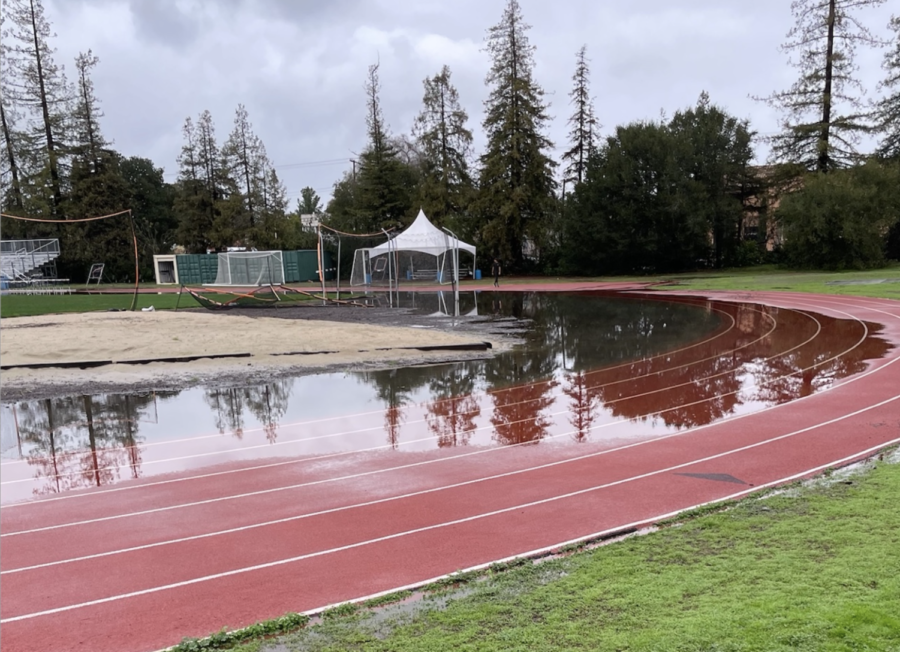From placing second at the Nike Indoor Nationals in the four-by-mile to finishing in 12th at the national Woodbridge Cross Country Classic, both the Menlo track & field and cross country teams have accomplished a variety of feats throughout the year. Yet despite their noteworthy performances, Menlo does not host track meets, in part due to the quality of Cartan’s track.
A standard track is 400 meters, but Menlo’s track is 440 yards (about 402 meters). This disparity, combined with the uneven surface of the track, poses difficulties for hosting meets. “If you’re running, there are some areas in the track where [the surface] is not even and it drops a tiny bit,” junior and track runner Alex Boesch said.
Due to the recent winter storms, water runoff has at times covered part of the track. When it rains, the water seeps under the track. “The Menlo track had about six inches of water standing on it because the drainage for that facility is not where it needs to be,” cross country coach Brad Hauser said.
The track also doesn’t have an electricity source near the finish line, so the track coaches must run power cords in order to have electronic timing. Electronic timing eliminates the possibility of human error and allows for more accurate results than using a stopwatch.
Although the track may not be ideal, assistant track & field coach Jake Fauver feels it is unrealistic to expect perfection. “This is the first high school I have worked at that has a track, so I’m used to sharing tracks with other schools or having to go to the community track,” Fauver said. “If you have got a surface you can run on, that’s all that really matters.”
While sophomore and track runner Joshua Benyo Baker is grateful for the facilities the track team has, he believes there is a disparity between the quality of the track and the competitiveness of the team. Graduating seniors Justin Pretre and Aiden Deffner are continuing their track careers at the collegiate level, and many of their teammates are ranked nationally.
Director of Athletics Earl Koberlein plans to resurface the track in the coming year, a process typically done every three to four years that removes the worn layer and replaces it with a smooth and even surface. Koberlein also has dreams of renovating the Cartan complex altogether; however, he must cater to multiple sports with limited space. Because Menlo College is the steward of Cartan, Koberlein must also make arrangements with the college before resurfacing the track. “It’s like a puzzle,” Koberlein said. “We have to consider the [Menlo] College’s needs, our needs, and the town’s. It’s a complicated situation.”
In addition to resurfacing the track, Menlo is also in the process of ordering a high jump mat. The quality of the track & field team’s equipment for field events limits their ability to host meets. The team doesn’t have a pole vault pit and their long jump pit and throwing facilities are in poor condition. According to Fauver, many other high schools lack similar equipment as well.
Although the lack of equipment for field events doesn’t bother Boesch personally, he feels that it could impact new runners attempting various events. “For really young runners who are coming into track & field and trying all the different events, it’s probably helpful to try out high jump and figure out what you like,” Boesch said. “So lacking those sorts of facilities is a problem there.”
Hauser agrees with Boesch. “I think Menlo does a fantastic job of encouraging students to try new sports, and I think not having some of those optimal facilities and equipment probably limits the number of kids that want to try,” Hauser said.
However, Hauser also notes that the quality of the facilities doesn’t necessarily hinder the track & field team’s performance. “I believe that the quality of the team is driven by a lot more than just the facilities,” Hauser said. “It’s the students themselves, it’s the coaching, it’s the support they get from the school and their parents.”
Graduating senior and track runner Justin Pretre also feels that the team has been able to adapt to the facilities without allowing them to interfere with their training. “Even though we complain about [the track] sometimes, I think that we’re able to find workarounds and keep pushing,” Pretre said.
However, Pretre does note that the lack of meets at home means the team rarely sees student spectators and their spirit. “I wish that we had home meets because nobody comes to track meets ever,” Pretre said. “So if we had home meets maybe a few people would come.”
While Koberlein acknowledges the importance of quality athletic facilities, he attributes the success of the team today to their hard work instead. “If we had a shiny glowing track, it doesn’t mean we would run faster,” Koberlein said. “The athletes still need to put the work in and they do.”

